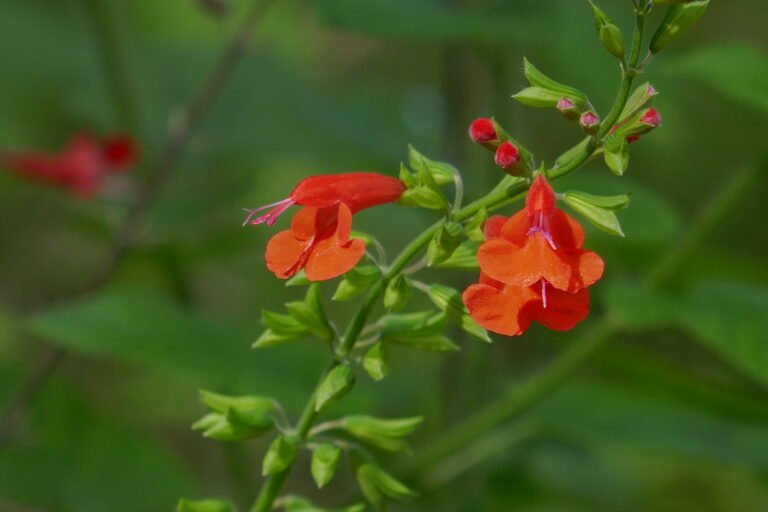
Salvia coccinea
(Tropical Sage)

Common Names, Latin Name, and Family
Some of its common names are tropical sage, blood sage, red sage, and red salvia.
Salvia coccinea
It is found in the Lamiaceae, or mint, family.
Form
Tropical sage is a native, perennial, wildflower that grows to a height of 3 to 4 feet.
Generally if it gets adequate sunlight it stays around 3-4 feet in height, but if it is searching for light it can get to 6 feet in height.
It prefers part shade with average soil moisture.
It will grow in full sun but will wilt in the afternoon heat if it’s not watered regularly.
Red salvia (my preferred common name) has a special place in my heart because it was the very first native wildflower I ever grew.

Leaves
Tropical sage leaves are opposite, stalked, and ovate to cordate in shape with toothed margins.
The leaves grow from 1/2 inch to 2 1/2 inch in length.
There are no basal leaves on this wildflower.
The stem is square as it is with all wildflowers in the mint family.

Flowers
The bright red flowers have two distinct lips. The lower lip provides the perfect landing platform for pollinators and has two lobes. They are about 1 1/8 inch in size.
The flowers appear all year in stalks and the flowers open from the bottom of the stalk upwards. The seeds ripen in the same way … from the bottom up.
They have two stamens that bend upwards creating the perfect arrangement for the pollinators to collect pollen on their backs as they move into the flower to reach the nectar.

Fruit / Seeds
The seeds are formed inside little green packets that turn brown when they are ripe.
If the seed stalk is tipped the seeds will fall out so when collecting seeds keep the stalk upright until it can be placed in your collection container.
Do not keep any seed capsules, or chaff, in your stored seeds because these seeds are prone to having tiny insects in their seed capsules and if they are accidentally put away for storage with the insects in them they will continue to eat the seeds and destroy your collected seeds. If you are storing your seeds for any length of time be sure to periodically check for insects.

Habitat
Tropical sage is found occurring naturally in thickets, disturbed sites and forest edges.
Native Range
It is found in all of Florida west to Texas, north to South Carolina and in the West Indies and Tropical America.
It is native to the following states AL, FL, GA, HI, LA, MS, OH, SC, and TX.
Landscape Use
In the home landscape it grows in part shade with average soil moisture.
It will grow in full sun but will wilt in the afternoon heat if it’s not watered often.
I prefer to grow it in part shade because it doesn’t require too much attention unless there are periods of drought.
It’s not picky about soil type and will grow in rich soil or poor sandy soil.
Do not over fertilize. Most wildflowers do not do well with fertilizer at all. A little bit of weak liquid kelp and chicken manure tea is what I use.
It is a great wildflower for container gardens.

Wildlife Use
The flowers are a source of nectar for many small insects including butterflies, bee flies, bumblebees, flower flies, wasps, and bees.
The red tubular flowers are a favorite of the ruby-throated hummingbird.
The ripe and unripe seeds and vegetation are eaten by songbirds and squirrels.

Propagation
Tropical sage can be grown from seeds or transplants. If you find seedlings coming up you can gently pull them out and transplant or put into pots.
The seeds can be direct sown or started in starter pots and planted out later.
I like to collect seeds and sprinkle them in and around existing flowers or flower pots.
Collect the seed pods once they start to turn brown. Not every single one has to be brown, but when the lower ones start to turn the upper ones may still be green because they ripen from the bottom of the stalk up, but the will be viable.
Place them somewhere to dry before you remove the seeds from the pods. Once they dry the pods, and seeds, will shrink slightly so the seeds will fall out very easily. Inside, in the air conditioning, is best place to dry them to avoid mold and mildew and provide a speedier desiccation of the pods. My favorite container is a white dishpan. They are big enough to spread the stalks out and the white helps me to keep an eye out for bugs that might start to infest the seeds. I can also see the tiny spiders, or other insects, that I need to rescue and take back outside.
I have seeds for sale at both my Ebay and Etsy stores …
Ebay Store – Red Salvia Seeds (Salvia coccinea) ✤ 50 Seeds
Etsy Shop – Red Salvia Seeds (Salvia coccinea) * 50 Seeds
